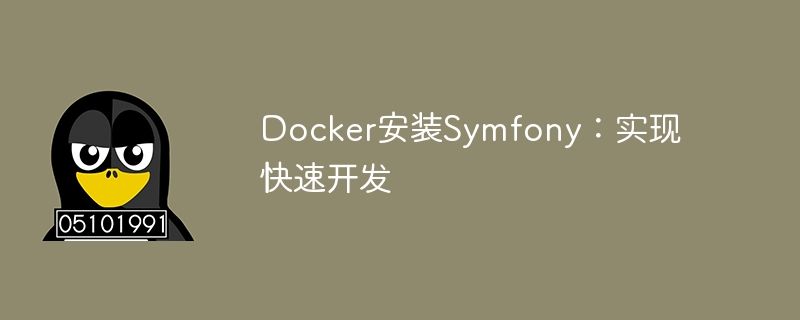Home >Operation and Maintenance >Linux Operation and Maintenance >Docker installs Symfony: achieving rapid development
Docker installs Symfony: achieving rapid development
- 王林Original
- 2023-10-21 10:37:481044browse

Docker installation of Symfony: for rapid development
Preface:
Symfony is a popular PHP framework that provides many tools and components to help developers Build high-quality web applications quickly. Docker is a containerization platform that can achieve rapid deployment of applications and isolation of environments. In this article, we will explore how to install and configure Symfony using Docker for rapid development.
- Installing Docker and Docker Compose
Before you begin, you need to install Docker and Docker Compose on your machine. You can find the corresponding installation tutorial on the Docker official website according to your operating system. After the installation is complete, you can run the following command in the terminal to verify whether the installation was successful:
docker --version docker-compose --version
- Create Symfony Project
In the terminal, use the following command to create a new Symfony project :
docker run --rm -it -v $(pwd):/app composer create-project symfony/website-skeleton my-symfony-app
The above command will create a new Symfony project using Composer, and the project will be stored in the "my-symfony-app" folder in the current directory.
- Create Docker configuration file
Create a file named "docker-compose.yml" in the root directory of the Symfony project to define the configuration of the Docker container.
version: "3"
services:
web:
build: .
ports:
- "8000:8000"
volumes:
- .:/app
depends_on:
- db
db:
image: mysql
environment:
MYSQL_ROOT_PASSWORD: root
MYSQL_DATABASE: symfony
MYSQL_USER: symfony
MYSQL_PASSWORD: symfonyThe above configuration file defines two services: web and db. The web service uses the Dockerfile in the current directory to build the container and mounts the Symfony project into the container's /app directory. The web service also maps the container's port 8000 to the host's port 8000. The db service uses the official MySQL image and defines some environment variables.
- Create Dockerfile
Create a file named "Dockerfile" in the root directory of the Symfony project to define the configuration of the Docker image that creates the web service.
FROM node:14 AS build-node WORKDIR /app COPY . /app RUN npm install && npm run build FROM php:8.0-apache WORKDIR /app COPY --from=build-node /app /app RUN docker-php-ext-install pdo pdo_mysql
The Dockerfile above defines two stages. In the first stage, front-end resources are built using Node.js images. Then, in the second phase, the Symfony application is built using PHP and the Apache image, and the front-end resources are copied into the container.
- Build and run the Symfony application
In the terminal, use the following command to build and run the Symfony application:
docker-compose up -d --build
The above command will be based on docker-compose Configuration in .yml file to build and run the container. The "-d" flag sets the container to run in the background.
- Visit the Symfony application
Open your browser and visit "http://localhost:8000", you will be able to see the Symfony welcome page. At this point, you have successfully installed and configured a Symfony application using Docker.
Summary:
This article explains how to use Docker and Docker Compose to install and configure Symfony applications. By deploying Symfony into a Docker container, we can quickly set up a development environment and achieve rapid application deployment and environment isolation. I hope this article was helpful and I wish you success in your Symfony development!
The above is the detailed content of Docker installs Symfony: achieving rapid development. For more information, please follow other related articles on the PHP Chinese website!
Related articles
See more- Detailed explanation of system routing of Symfony2
- Detailed explanation of how to query the database with Symfony2
- How to solve the problem that the docker suite in Synology NAS fails to query the registry
- What is the difference between copy and add instructions in docker
- What are the advantages of docker

